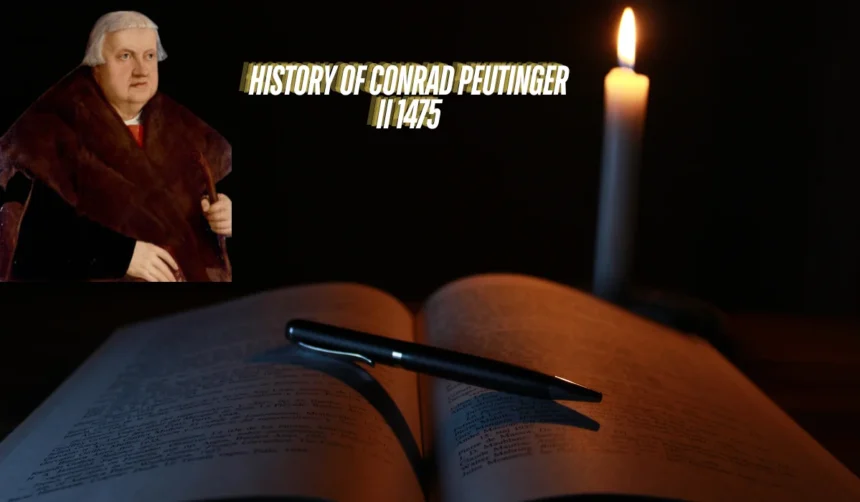Introduction to Conrad Peutinger ii
In the vibrant tapestry of the Renaissance, a period marked by rebirth and discovery, certain figures shine brightly in the annals of history. Yet, among these luminaries, some remain overshadowed despite their profound contributions. One such figure is Conrad Peutinger II 1475. A man whose intellect spanned across various disciplines—from cartography to humanism—Peutinger’s influence resonates through time even if his name isn’t always recognized alongside giants like Leonardo da Vinci or Michelangelo.
This blog post invites you on a journey into the life and legacy of this hidden visionary who played an essential role during one of humanity’s most transformative eras. Get ready to uncover how Conrad Peutinger II 1475 shaped our understanding of geography and culture while navigating the intricate web of Renaissance thought!
Early Life and Education
Conrad Peutinger II 1475, was born in Augsburg, a city bustling with cultural transformation. His early years were marked by the rich tapestry of Renaissance thought that surrounded him.
Growing up in a well-to-do family allowed him access to education from an early age. He displayed curiosity and intelligence, quickly gravitating towards subjects like history and geography.
His educational path took him to prestigious universities such as Ingolstadt and later Pavia. Here, he delved into classical texts, absorbing knowledge from ancient scholars while forging his own intellectual identity.
Peutinger’s thirst for learning set the stage for his future contributions to cartography and humanism. The foundations laid during his formative years would shape not only his career but also influence generations after him.
Rising Through the Ranks
Conrad Peutinger II 1475 ascent in the early Renaissance was nothing short of remarkable. Born into a well-to-do family, he leveraged his connections and education to navigate through various societal circles.
His keen intellect caught the attention of influential figures in Augsburg. This led to opportunities that would shape his career. He initially took on roles within public administration, where he honed skills that would later serve him in his cartographic pursuits.
As he continued rising through the ranks, Peutinger became known for his ability to blend knowledge with practicality. His work not only reflected scholarly wisdom but also addressed real-world needs of navigation and exploration.
This unique combination paved the way for collaborations with prominent scholars and artists. Each partnership further solidified his reputation as a key player during this transformative era in history.
The Renaissance Influence on Peutinger
The Renaissance was a time of revival, curiosity, and exploration. It transformed the way people viewed art, science, and the world around them. In this vibrant context, Conrad Peutinger II 1475 emerged as a key figure.
He embraced humanism’s ideals that emphasized education and knowledge. This movement inspired him to explore ancient texts and maps with renewed vigor. As he delved into classical geography, his work reflected this enriched perspective.
Peutinger’s passion for cartography blossomed during these years of enlightenment. He sought to merge scientific inquiry with artistic expression in his maps. His innovative approach set him apart from many contemporaries.
As cities expanded and trade routes flourished, so did the demand for accurate representations of geography. Peutinger answered this call by creating detailed maps that captured both beauty and precision—a true hallmark of Renaissance thinking.
His Contributions to Cartography
Conrad Peutinger II made significant strides in the field of cartography during the Renaissance. His maps were not just artistic expressions; they were essential tools for navigation and understanding geography.
Peutinger’s most notable work, the Peutinger Table, is a remarkable Roman road map that charts ancient routes across Europe, North Africa, and parts of Asia. This extensive representation provided insights into trade networks and territorial boundaries.
His ability to synthesize information from various sources set him apart from his contemporaries. He meticulously compiled data from ancient texts and contemporary explorations, creating a comprehensive view of known lands.
Additionally, his attention to detail paved the way for more accurate depictions of regions. The scale he employed was innovative for its time, helping users grasp distances between cities and landmarks effectively.
Through these contributions, Conrad Peutinger II 1475 left an indelible mark on cartography that influenced future generations of explorers and geographers alike.
Legacy and Impact of Conrad Peutinger ii 1475
Conrad Peutinger II 1475 left an indelible mark on the fields of cartography and humanism. His innovative approach to maps set a new standard for accuracy and detail, influencing generations of scholars.
His work provided insights into ancient geography that were previously overlooked. By synthesizing classical texts with contemporary knowledge, he created a bridge between eras. This melding of information not only showcased his brilliance but also enriched the understanding of historical landscapes.
The influence of Conrad Peutinger II 1475 extends beyond his time. Modern historians often reference his contributions as foundational in the evolution of geographic studies. His legacy is a testament to how one visionary can reshape entire disciplines through passion and dedication.
Peutinger’s efforts were instrumental in reviving interest in classical cartography and integrating it with the Renaissance’s spirit of rediscovery and innovation. His work exemplifies how Renaissance scholars were not only rediscovering the past but also reshaping it to fit the intellectual and cultural context of their time.
Today, libraries and institutions continue to celebrate his achievements. Exhibitions featuring Podeger’s maps attract scholars eager to explore this Renaissance figure’s impact on our perception of space and history.
Uncovering the Hidden Visionary: Rediscovering Peutinger’s Works and Legacy
Conrad Peutinger II 1475 contributions often slip under the radar in discussions of Renaissance thinkers. Yet, his work is a treasure trove waiting to be explored.
His maps and writings reveal an intricate understanding of geography that blended ancient knowledge with contemporary insights. These pieces are not just artifacts; they offer a glimpse into how people viewed the world during a time of great change.
Rediscovering Peutinger means diving into his meticulously crafted maps, such as the famous Peutinger Table. This unique representation of the Roman Empire showcases trade routes, cities, and landmarks with stunning precision.
Scholars today are revisiting his influence on cartography and historical scholarship. They highlight how he bridged gaps between various disciplines—much like many Renaissance figures did—with an innovative spirit that deserves broader recognition.
Peutinger’s legacy invites us to appreciate the interconnectedness of history and geography through fresh eyes. His vision continues to inspire modern explorers in both academic fields and practical applications alike.
Rediscovering the Peutinger Table in 1475
The Peutinger Table, a remarkable artifact of Roman cartography, found new life thanks to Conrad Peutinger II 1475. This ancient map, originally created in the 4th century AD, was pivotal for Renaissance scholars seeking to understand the Roman world. Peutinger’s detailed examination and interpretation of this map in 1475 demonstrated his scholarly prowess and dedication. By bringing the Peutinger Table back into the spotlight, he contributed to a deeper appreciation of Roman geographical knowledge and its relevance to contemporary Renaissance studies. His work provided crucial insights that helped shape the era’s understanding of historical geography.
Conclusion of Conrad Peutinger ii 1475
Conrad Peutinger II 1475, stands as a remarkable figure of the Renaissance. His life and work reflect the dynamic spirit of an era that embraced exploration and knowledge. From his early education to his rise within various ranks, each phase played a crucial role in shaping his intellectual pursuits.
Peutinger’s profound engagement with cartography marked him as more than just a scholar; he was a pioneer who bridged ancient wisdom with contemporary thought. His maps served not only navigational purposes but also ignited curiosity about geography and history among scholars of his time.
The legacy he left behind is often overshadowed by more prominent figures, yet it remains vital for those interested in the evolution of cartographic science. Rediscovering his works allows us to appreciate how one individual can influence generations through their dedication to learning and sharing knowledge.
As we delve deeper into history, it becomes clear how essential figures like Conrad Peutinger II 1475 are for understanding our past while inspiring future innovations. The Renaissance may have been an age filled with renowned artists and thinkers, but hidden gems like Peutinger remind us there’s always more to discover beneath the surface.










